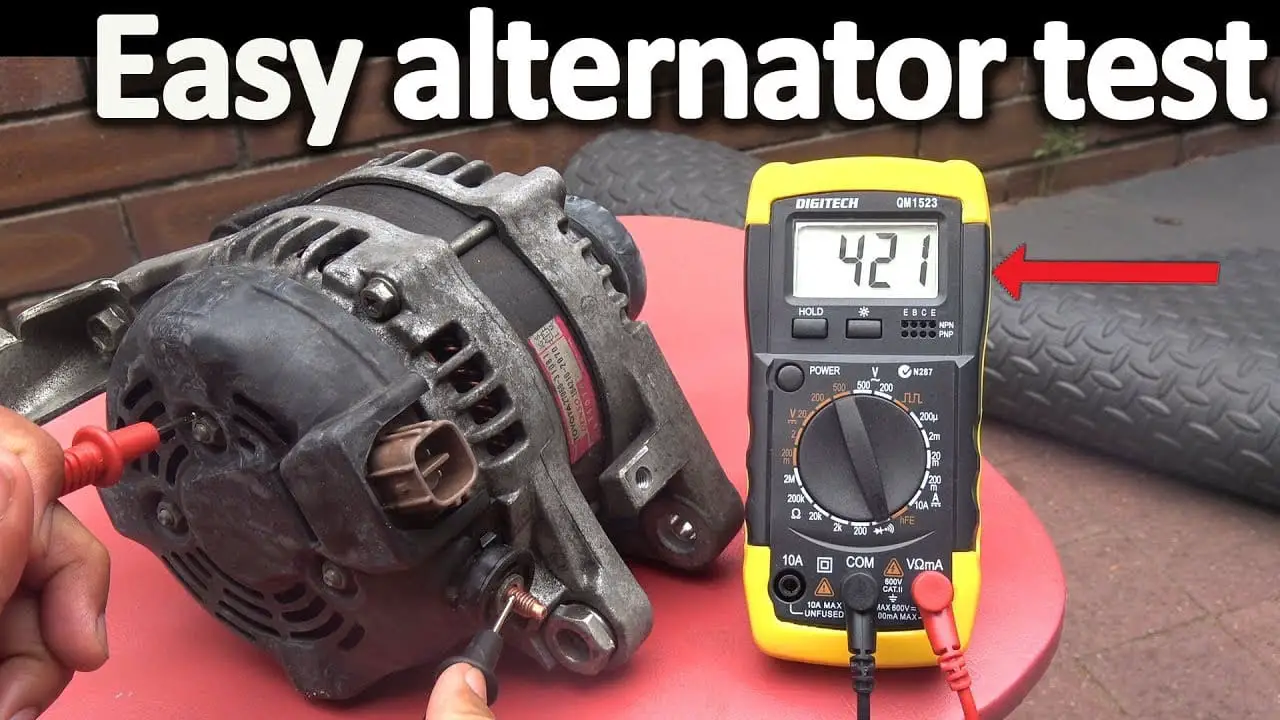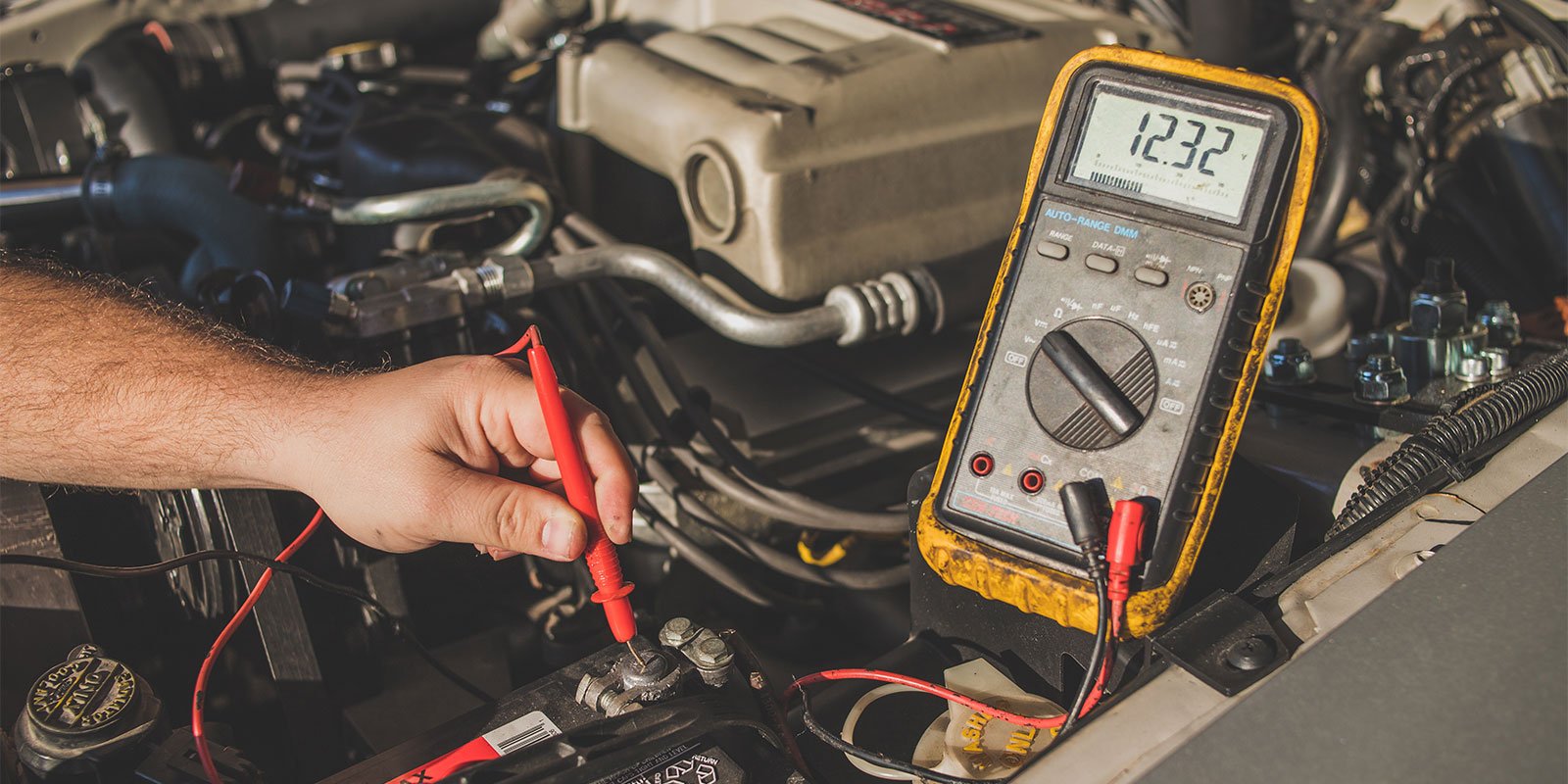Overly Bright Or Dim Lights
Why is this the case? Because when your alternator becomes faulty, it will provide inconsistent power to your electronic accessories. Therefore, your accessories may begin or over-perform or under-perform.
For example, this may manifest itself as extremely bright headlights or very dim headlights. If you also experience flickering of lights and similar behavior, it’s time to check your alternator.
Buy Voltmeter And Multimeter
As we have seen voltmeters and multimeters are some of the devices that you can use for testing an alternator off the car. If you want to know more about these devices and how they work, let us know. At ICRFQ, we are a reliable supplier and sourcing agent for the voltmeters and multimeters in China.
If you want to find more Electronic Components Distributors, please check out the following articles:
Check The Battery First
When your battery charges the alternator, it creates a moderate amount of friction that can rotate the alternator at speed enough to fill the battery with electricity.
Like everything else, batteries arent perfect, and if they dont get charged, they wont have enough power to start your engine, and consequently, you will not be able to test the alternator.
You should check the battery first before determining the condition of the alternator, particularly if its cold outside or the battery is old.
If the battery is the problem, the alternator may be working fine.
Heres how to test your battery:
- Turn off the car. You should verify the engine is shut down before you connect the Voltmeter.
- Lift the hood.
- Take the Voltmeter and attach it to the battery. Connect the green probe wire to the batterys positive terminal, then attach the black probe wire to the negative terminal of your battery. Never let the metal connectors come in contact with your skin, as it could be potentially dangerous.
- Check the Voltmeter a battery that has a voltage reading of over 12.2 will serve as a good starting power source for the alternator.
- The battery should be fully charged before setting the alternator to test, or you can use an alternative method to test the alternator if it is producing insufficient voltage.
Don’t Miss: How To Check Car Alternator
If Your Alternator Passes
- If you connect the meter leads to the battery terminals and the meter shows that its in the 13.8 to 15.3-volt ranges , that means the alternator is working as it should be.
- If the alternator is functioning correctly, its likely that your dead battery was caused by a computer module that isnt shutting down when you turn off the car. If your alternator passes the voltmeter test, get your vehicle into a shop and pay a professional mechanic to find and correct the misbehaving module.
Growling Or Whining Noise

If you hear some growling or whining noise coming from under the car’s hood, it’s time for an alternator check-up. Although your vehicle may make several noises that are harmless, it’s important to trust your gut on which ones are actually warning sounds.
So, what causes these growling or whining sounds? It is likely a result of the bearings responsible for spinning the rotor shaft becoming faulty. Another reason could be that the alternator belt has become misaligned.
You May Like: How Much To Fix A Scratch On A Car
How Can I Test My Alternator
In the past, it was common for people to try and check their alternator by disconnecting the negative battery cable. Our advice: Dont do it you risk burning out every electrical device in your vehicle because when there is no battery to act as a buffer in the circuit, the alternator can put out up to 150 volts, depending on the engines rpm. This easy alternator test could cost you thousands of pounds in damage. There are, however, a couple of simple and safe alternatives to test your alternator.
How To Test An Alternator Off The Vehicle
As we have mentioned, you can easily test an alternator off the vehicle. Lets outline the steps and the tools that you will need for doing the testing.
The main tools that you will need for the job include
-Voltage meter
-Socket set with a 17mm and 19mm socket
-Pliers/small file to clean the contacts on the alternator.
Steps:
Recommended Reading: Can My Car Be Towed Without Warning
How To Test Alternator
Alternator problems manifest themselves in various ways, depending upon the particular failure. Still, using a few simple tests at home that show you how to test an alternator, how to inspect a battery, if necessary, and check a drive belt will help you pinpoint the cause of the problem.
These tests only take a few minutes, and you don’t have to remove the alternator from your car.
For the main tests, you’ll only need a digital multimeter. However, if you have to test the battery, you’ll need a hydrometer tool as well.
It’s a good idea to buy the service manual for your particular vehicle model so that you have the electrical specifications and particular procedures that apply to your car model. The manual will pay for itself if you plan on doing some maintenance and simple repairs yourself.
You can get an inexpensive aftermarket manual at your local auto parts store. Also, Amazon offers many of these repair manuals at low prices as well.
NOTE:Some auto parts stores will charge your battery and check the operation of your alternator free of charge. If you don’t have a digital multimeter or a hydrometer and can’t buy the tools now, you can take advantage of this to establish the condition of both system items at once.
How Do I Know My Alternator Is Failing
While its unlikely that an alternator will completely fail without notice, there are some symptoms that will let you know the alternator is on its way out. The most obvious sign is the battery light on your dashboard. Other symptoms can include frequent dead batteries, dim lighting, worn bearing noise, battery light illuminated on the dash, or miscellaneous electrical issues.
If you suspect your alternator is giving you trouble, it might be time to perform a test.
You May Like: What Size Wheels Are On My Car
Check If The Alternator Passes The Test
If you attach the meter leads to the battery terminals and the meter reads 13.8 to 15.3 volts , the alternator is working properly.
If the alternator is working properly, your dead battery is most likely the result of a computer module that isnt shutting down when the car is turned off. If your alternator passes the voltmeter test, take your car to a shop and hire a skilled mechanic to locate and repair the malfunctioning module.
How To Test Alternator Amperage Output
In addition to checking the alternator’s voltage output, you also need to check its current or amperage output. Amperage is how much current the alternator generates at a specified voltage and speed. Not long ago, an 80 amp alternator was considered a high output unit. Most late model alternators produce 120 to 155 amps or more. Current output increases with engine speed, from around 20 to 50 amps at idle up to the unit’s maximum output at 2,500 RPM or higher .
Charging output can be measured with an inductive amp probe clamped around the BAT wire that connects to the alternator. It can also be measured on an alternator bench tester in a auto parts store.
Alternator power ratings can also be given in Watts . Many alternators in foreign vehicles are rated in watts rather than amps. The important point here is to make sure a replacement alternator has the same power rating as the original so the charging system can maintain the same power output as before, should the alternator need to be replaced. In fact, on some applications upgrading to a higher output replacement alternator may be recommended if the vehicle has a history of alternator failures, or the vehicle has a megawatt aftermarket sound system, emergency or off-road lighting, or other power-hungry electrical accessories.
You May Like: How To Find Car History
Signs That Indicate Your Car Alternator Is Weak
The followings are the signs that indicate your alternator is weak:
- The dashboards battery light is on.
- Your engine is slow to start or wont start at all.
- The batteries, headlights, and/or interior lighting appear to be in poor condition.
- Rumbling or squeaking sounds are coming from the alternator.
- Youve attempted but failed to jump-start your vehicle.
The symptoms listed above could potentially indicate a failing car battery.
Read more: Understanding Engine Starter Motor
How To Test An Alternator By Disconnecting The Battery

Another, riskier technique of checking the alternator is to completely detach the battery from the vehicle while it is still running disconnect the battery while the vehicle is still running and see whether it continues to operate. If it does, it signifies the alternator is still putting out enough power to keep the engine running. If it doesnt, its because the alternator isnt putting out enough power.
It is simple to test the alternator of a car simply detaching the battery. Heres a quick guide to help you out:
Always do the test in a public and secure location. You can, for example, conduct this test in the driveway. Make sure that children and dogs are kept at a safe distance before you begin. To guarantee that the car is in a stable position, inspect it multiple times. If youre happy with its position, you may begin testing by opening the hood. Sit in the drivers seat now.
You should start the car engine once you are in the drivers seat. If you have a problem with your cars alternator, you may have trouble starting it. You must exit the drivers seat once the car engine has started. While the vehicle is still running, you must disconnect the automobile battery at this point. Check to see if the automobile can run normally.
Watch the video below to learn how to test an alternator:
Recommended Reading: What Kind Of Car Does Columbo Drive
Checking For A Bad Diode
Usually, a bad alternator diode will cause your headlights or instrument panel lights to flicker or dim and, sometimes, drain battery power overnight, or in minutes.
* To check for a possible bad alternator diode, switch your voltmeter to a low setting on the AC voltage scale.* With the engine running, touch the meter probes to the battery terminals.* Your voltmeter should read 0 AC volts.
Any amount of AC voltage would indicate a bad diode, so you’ll need to replace the alternator.
When To Test An Alternator On A Car
Testing an alternator is not a task you must perform regularly. If a car is not having issues starting or powering its electronic features, the alternator is likely running efficiently and doesnt need to be checked. However, if a car is experiencing any of the issues listed below, its a good idea to test the alternator to ensure its working properly or determine if its due for a trip to the auto shop.
Read Also: How Old For Car Seat
How To Test Alternator Using A Voltmeter
An easy way to check on your alternators health is by using a voltmeter or multimeter, an instrument used to measure electric potential difference on two points of a circuit.
A multimeter is a handy tool to test your car’s electrical load
> > > Related: What do you need to know about testing car’s alternator for problems?
Theyre available in the market for as low as Php 200 and come with either an analog or digital voltage indicator. Youll need to connect them to alligator clips or standard probes. A pair of gloves will also be useful, as well as protective eyewear such as goggles.
What Is A Voltage Regulator
This is a system that’s designed to maintain a constant voltage automatically. The voltage regulator can make use of electronic components or an electromechanical mechanism.
It works by generating a fixed output voltage that remains constant despite any changes to its load conditions or input voltages.
You May Like: How To Build Your Own Car
How Can You Tell If It Is Your Battery Or Your Alternator
Some signs of a dead or dying battery:
- If your dashboard lights are dim, your battery could be dying.
- The cranking of your car sounds sluggish or clicks when trying to start your car.
Some signs the alternator is failing:
- Dim or fading interior lights
- Headlights get brighter while accelerating but dim when not accelerating.
- A squealing sound coming from the engine that gets louder when electronics are being used.
Test The Alternator With The Engine On
Next, test the alternator with the engine and electrical systems turned on.
If the voltage does not change when the engine is started, or if it does not read between a minimum of 13 volts and a maximum of 15 volts, the alternator may be faulty.
Now that you’ve checked your car’s alternator, it’s time to finish up.
If your tests result in normal voltage readings, but you still have issues with battery warning lights, a discharging battery, or your car’s electrical systems, further testing is needed. You may want to enlist the help of a professional mechanic who can test or replace the alternator for you.
YourMechanic offers car repair and maintenance services at the convenience of your home or office, 7 days a week, and saves you up to 30%. A version of this article originally appeared on YourMechanic.com: How to Test Your Alternator.
Don’t Miss: Where Can I Get My Car Key Cut
Remove The Negative Battery Terminal
Once you identify the negative terminal, simply pull the cable connected to the terminal while the cars engine is still running. You can use a wrench or pull it directly with your hand if a wrench is not available.
After that, carefully observe the outcome. If the cars engine performance drops, stalls, or dies down entirely, you have a bad alternator. Kindly replace the component immediately to protect the battery from further damage.
Meanwhile, if the engine keeps running without any interruption, it means the alternator is okay. For those asking how to test alternators without a multimeter, you may want to check out this video to guide you through the process properly.
Why Test Your Alternator

It is obvious that the alternator is a critical part of a modern vehicles electrical and charging system. It recharges the battery of your car to keep it working. The alternator also powers up the cars electrical system during operation. Hence, if there is a problem with the alternator, then you will experience a reduction in the functionality of these electrical systems.
You may notice your headlights getting dimmer than before. This can be dangerous when driving at night or in zero-visibility conditions. You may not have power to your air conditioning unit or your cars cabin heater, making your ride unbearable. The lights on your instrument panel may not turn on, leaving you in the dark as to your speed and other important vehicle data. Your car entertainment system will also not provide you with a remarkable experience. Any component in your car that requires electricity will start to malfunction.
It is for this reason that you should check the condition of the alternator. This is to make sure that it can generate sufficient voltage to operate the different electrical components of your car. Hence, if you see a battery warning indicator light in your instrument panel, it is always a good idea to test the voltage output of your car.
Also Check: Who Is The Cheapest Car Rental
How To Test A Car Alternator
Equipment needed: multi-meter
With the engine on:
- Step 1: Open your hood and so you have clear access to the car battery. Locate your alternator and check to be sure the alternator belt isnt loose.
- Step 2: Turn your multi-meter to the 20 V setting.
- Step 3: Start the engine. At this point, check to make sure the alternator pulley / belt is spinning properly without slipping.
- Step 4: There are two ways to test the voltage coming from the alternator. If you have easy access to the alternator without getting your body parts / clothing / etc tangled in the spinning pulleys, then place the positive multi-meter probe and touch it to the red terminal connector coming out of the alternator. Now take the negative multi-meter probe and touch it to some metal part of your car frame . Dont ground to the alternator itself. That would be potentially bad. You should now be getting a reading on your multi-meter display. If you dont have good access to your alternator, then you can simple test the alternator by touching the positive multi-meter probe to the positive terminal on your battery and likewise the negative probe to the negative terminal on your battery.
If you liked this article, you might also enjoy our new popular podcast, The BrainFood Show , as well as:
